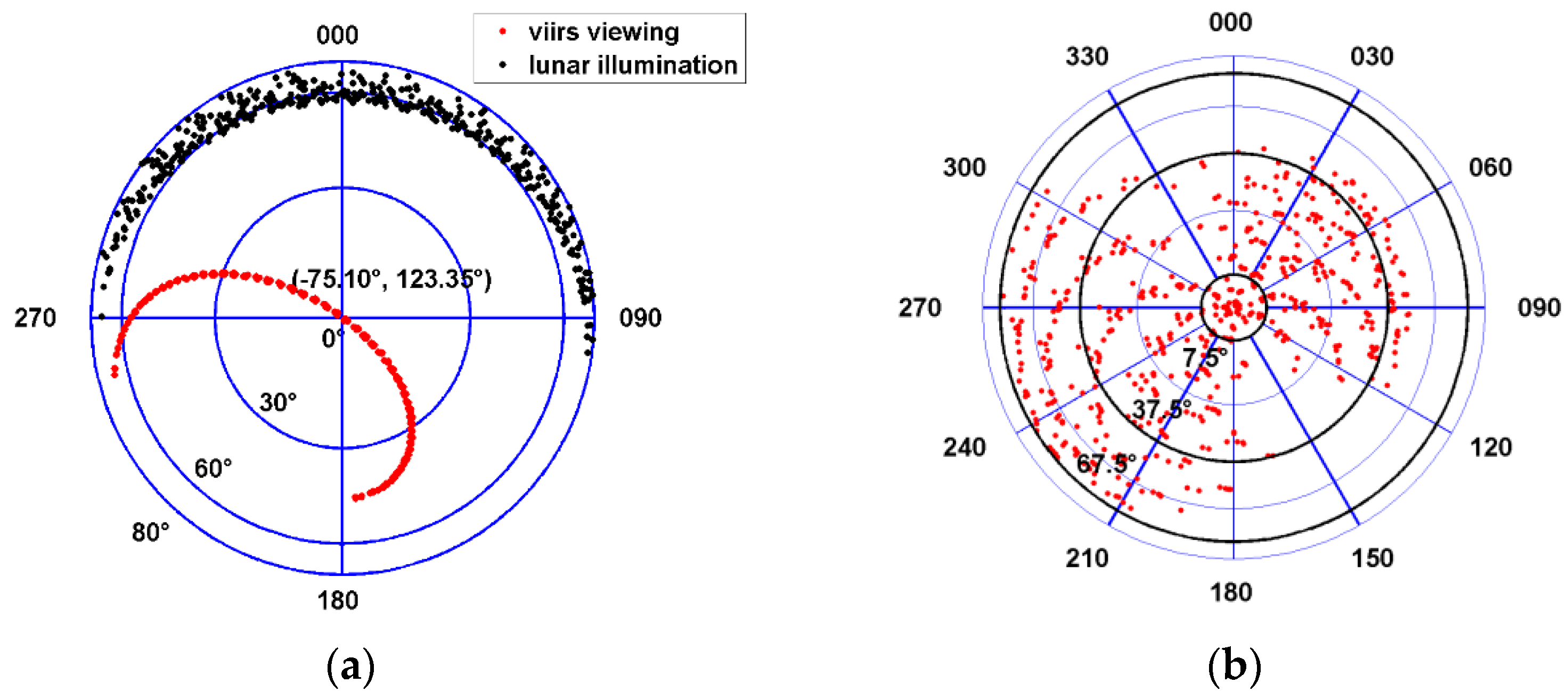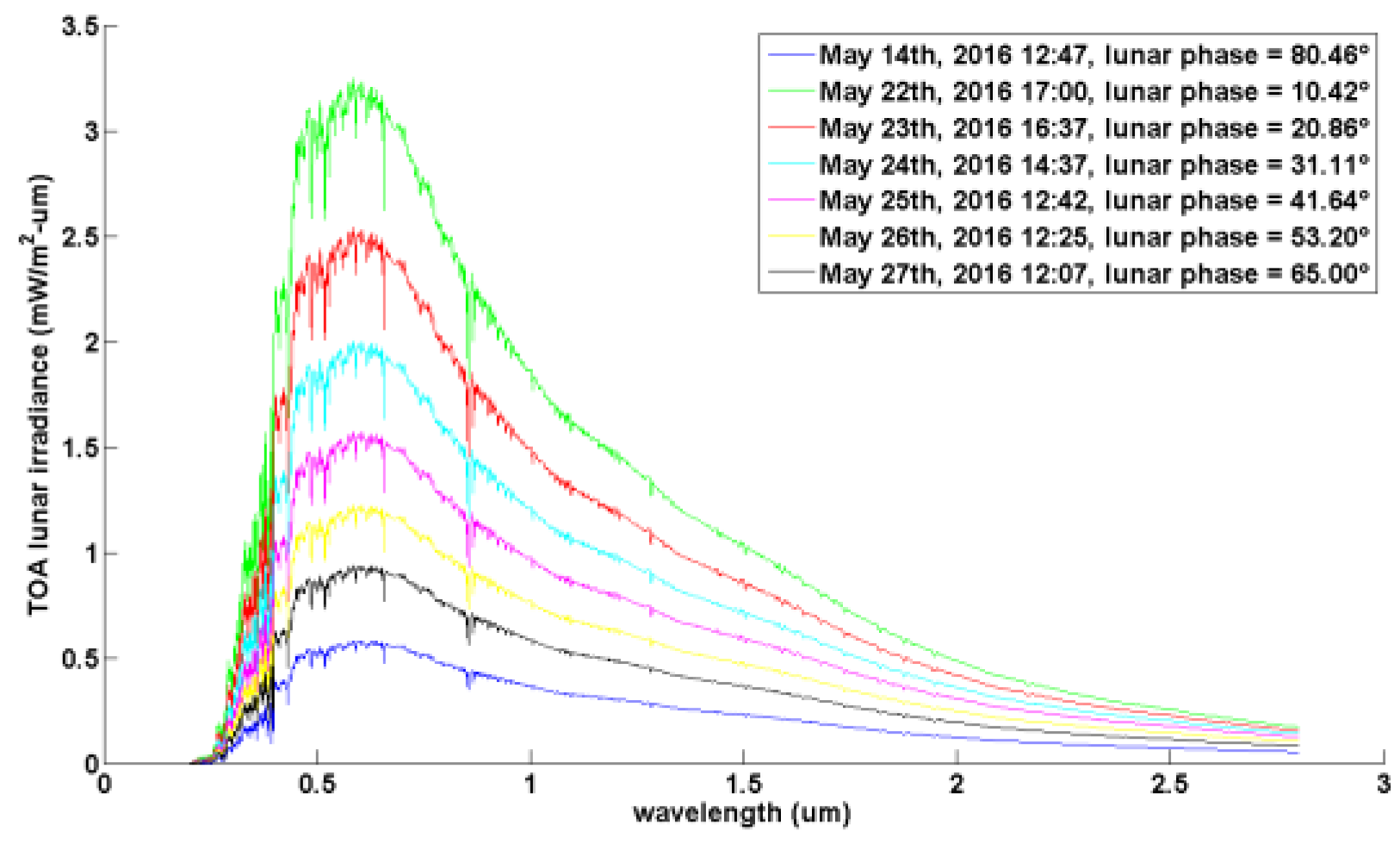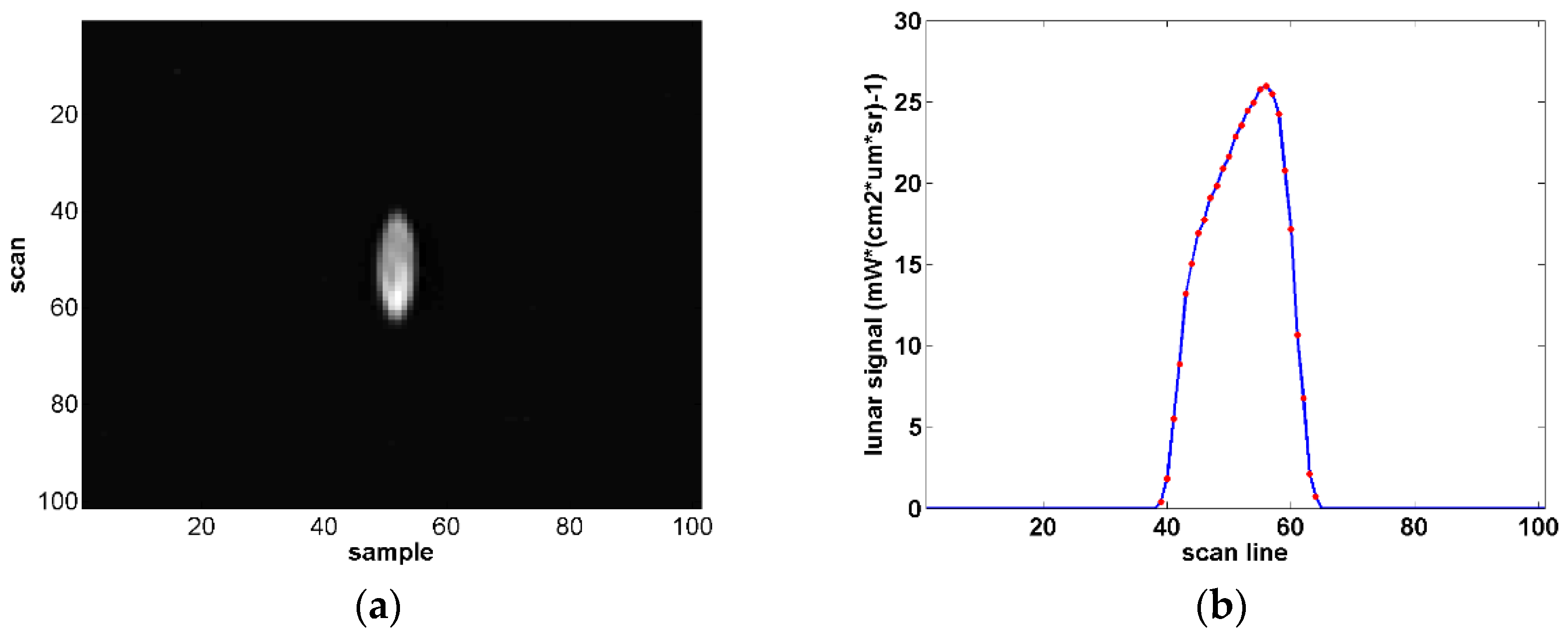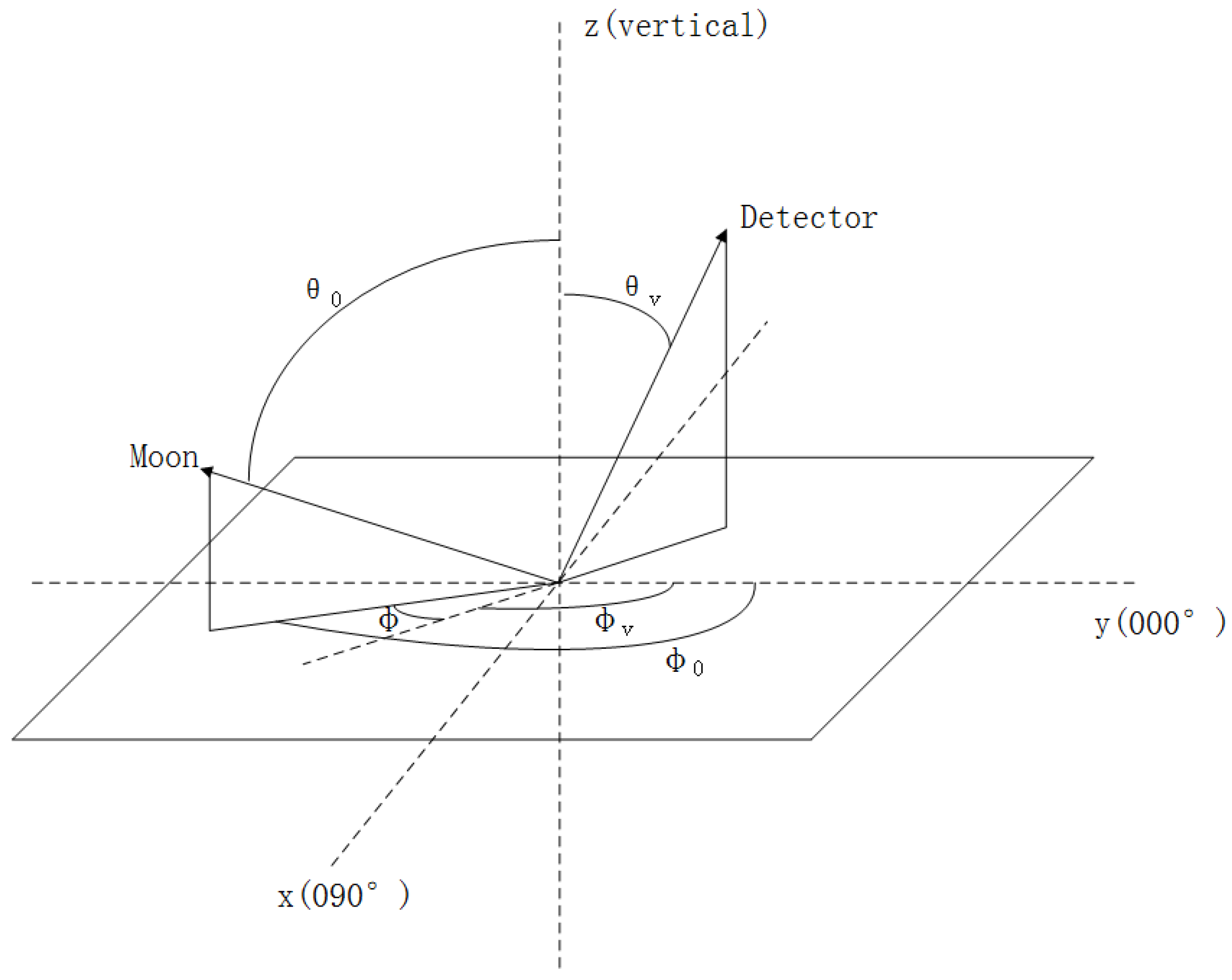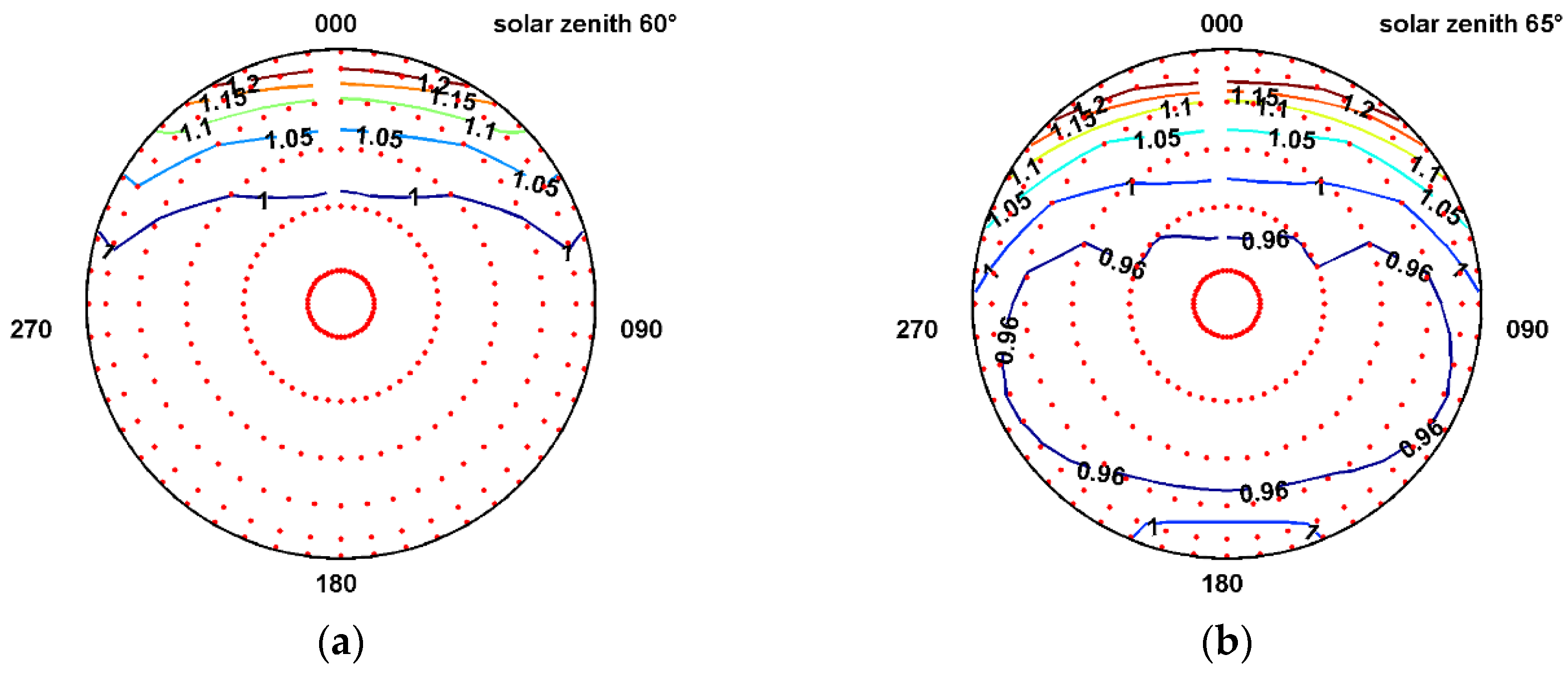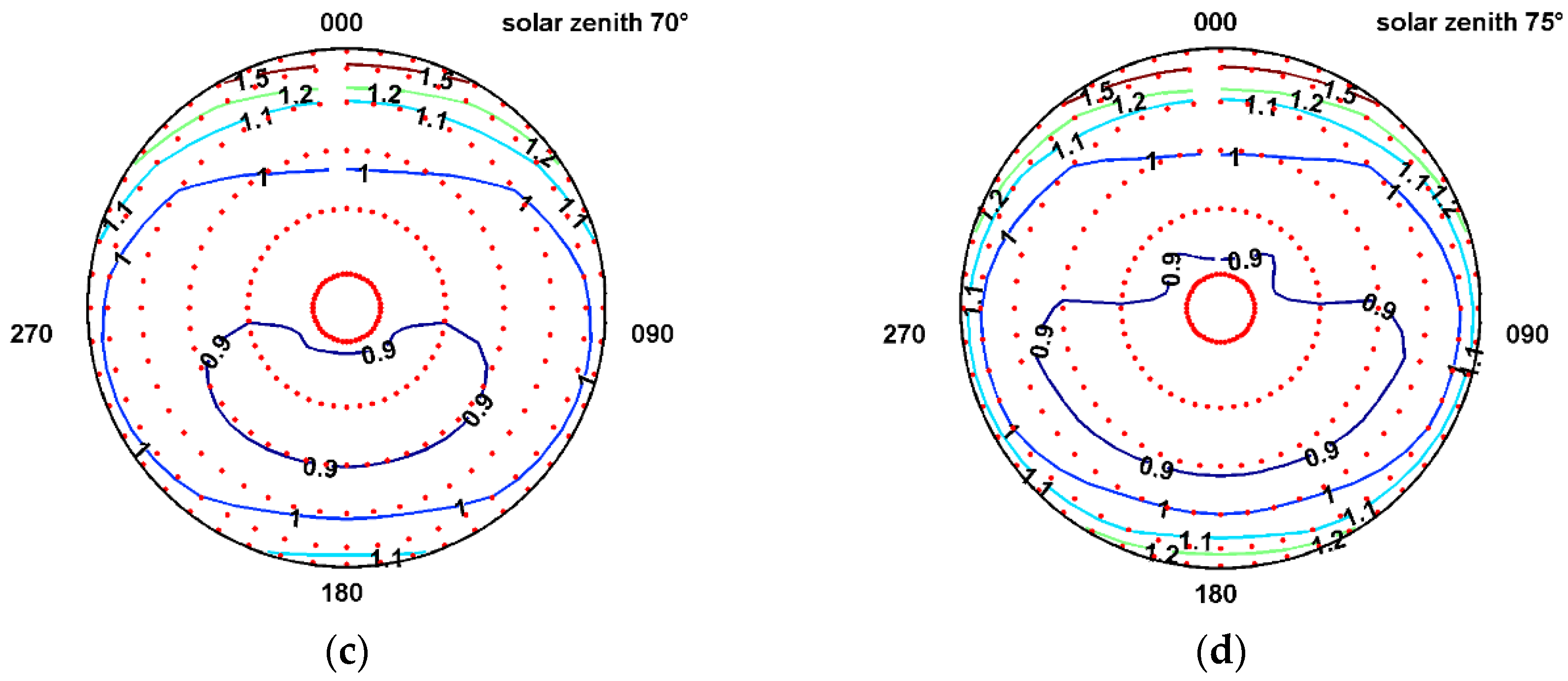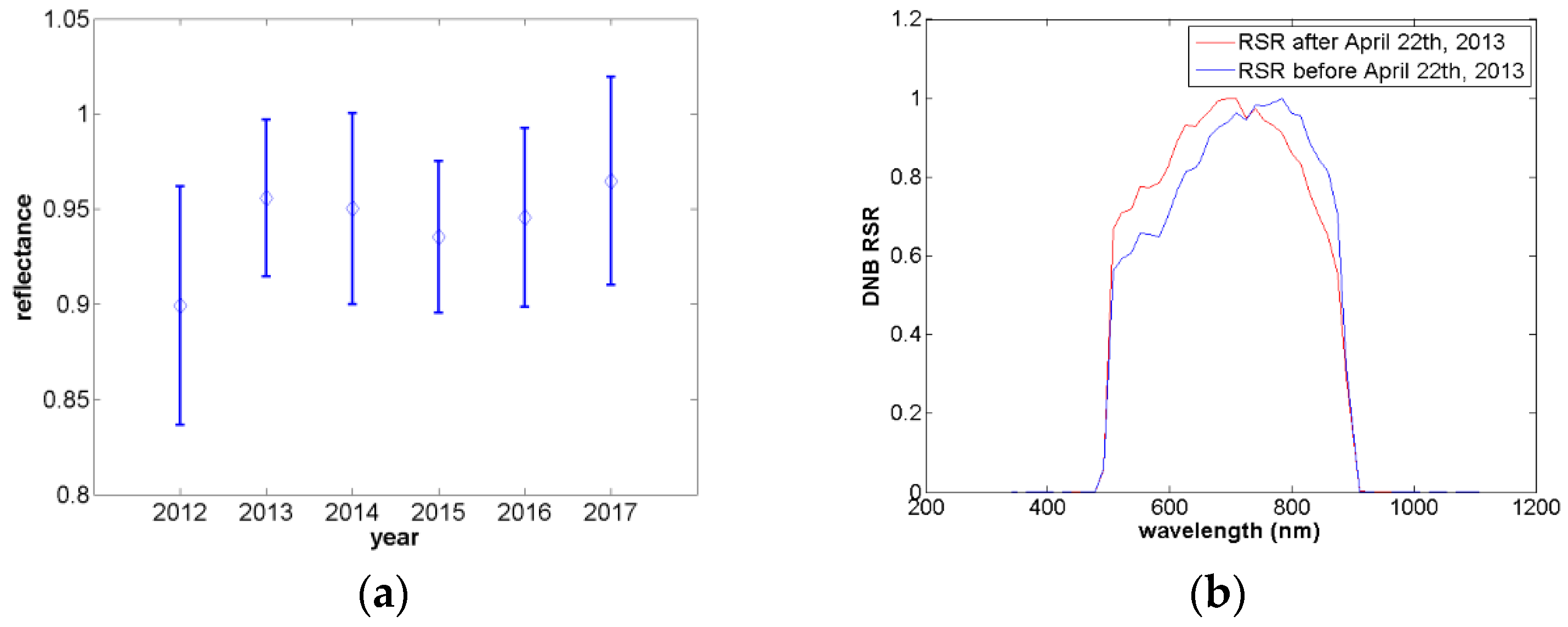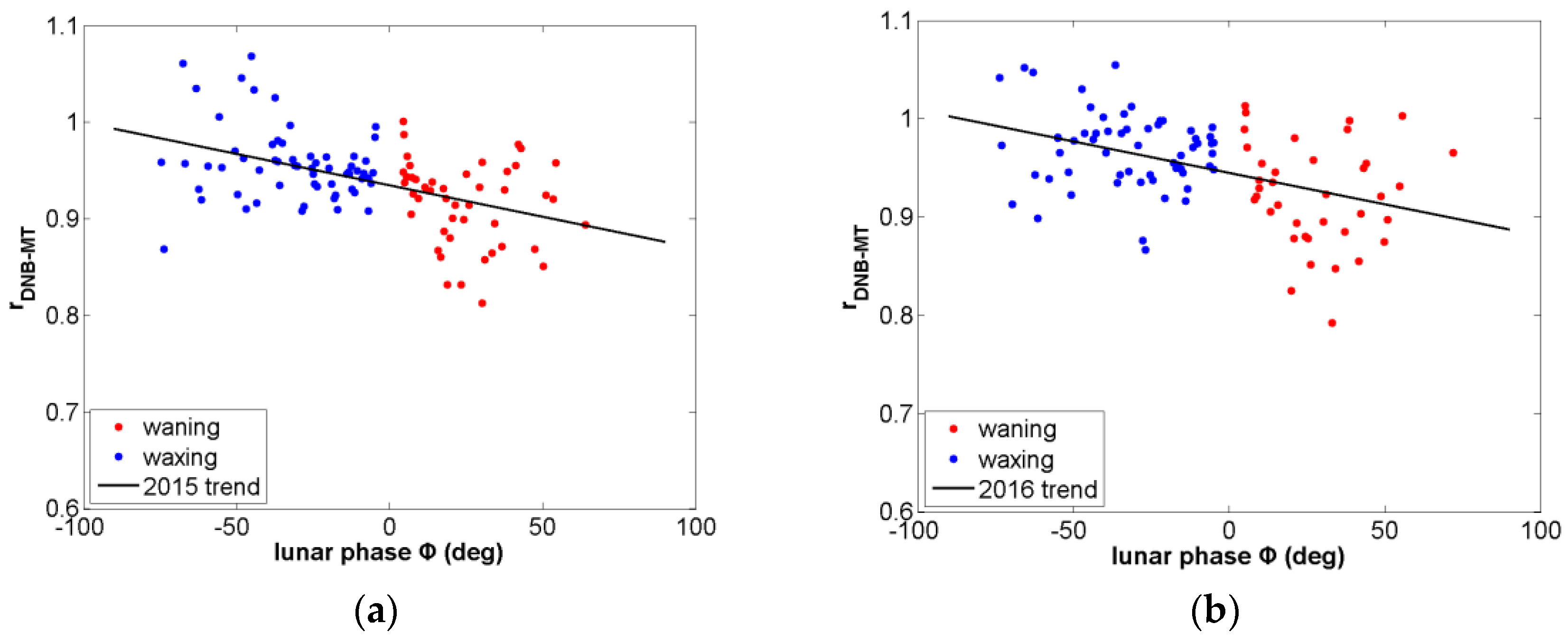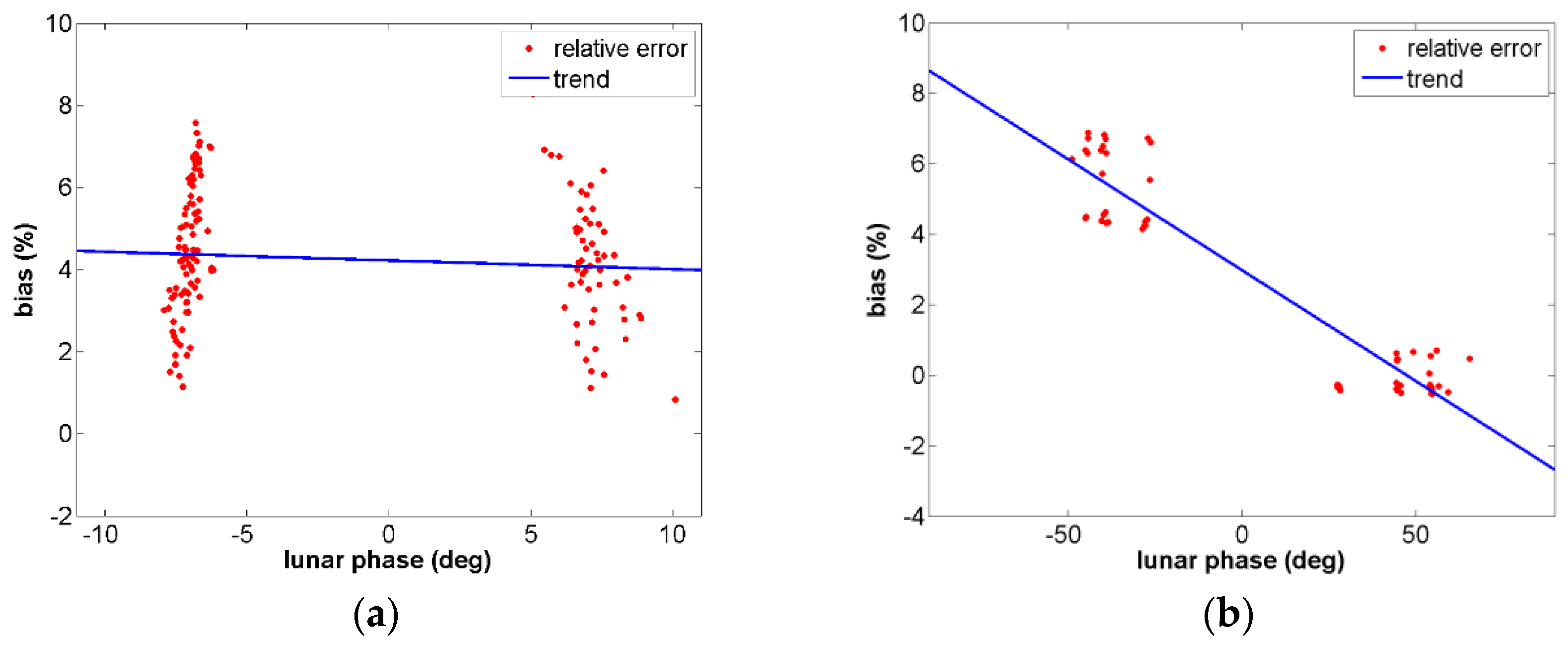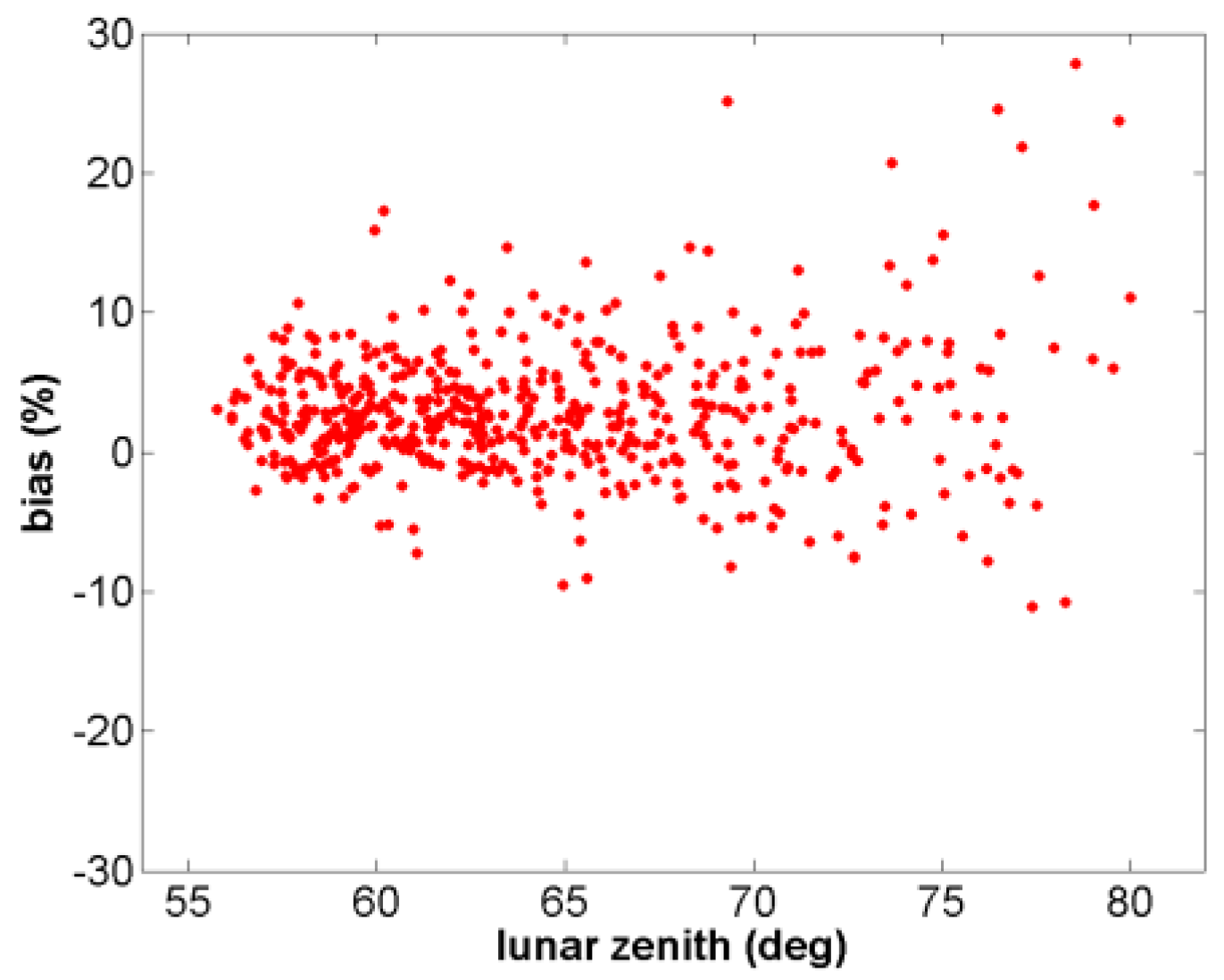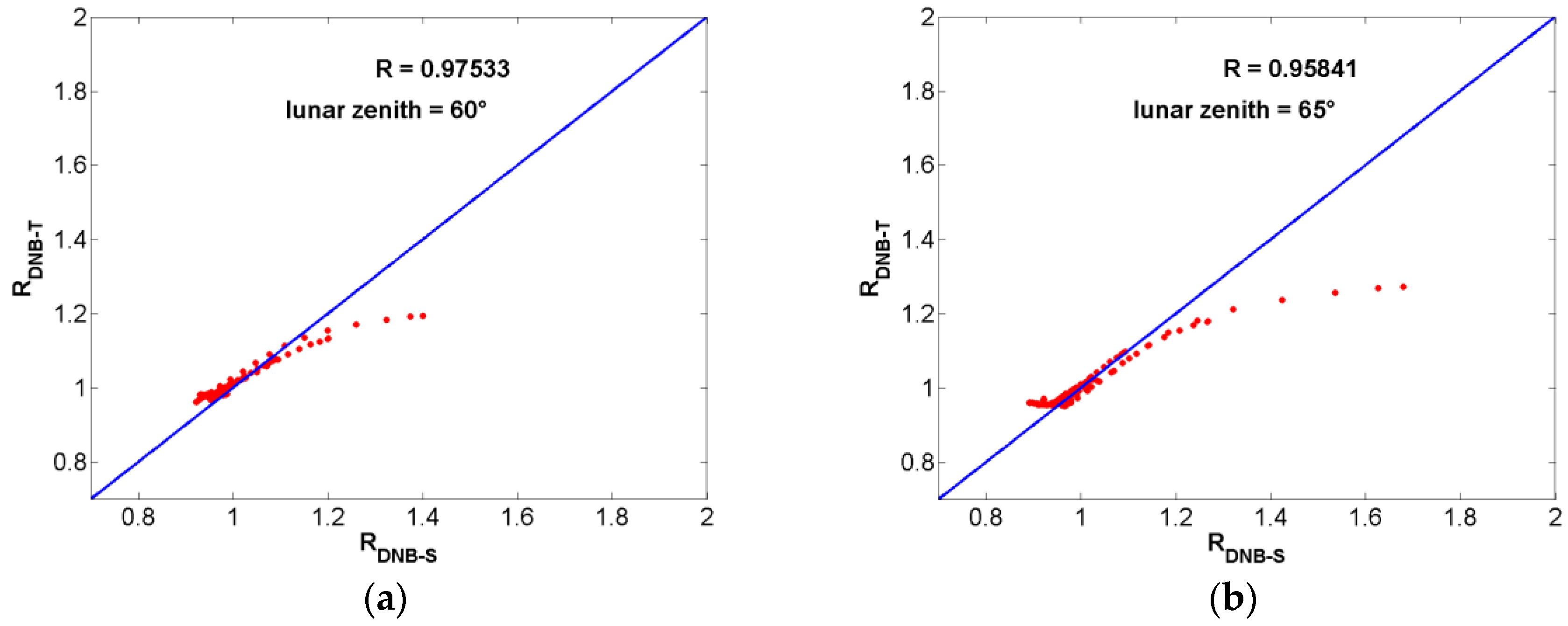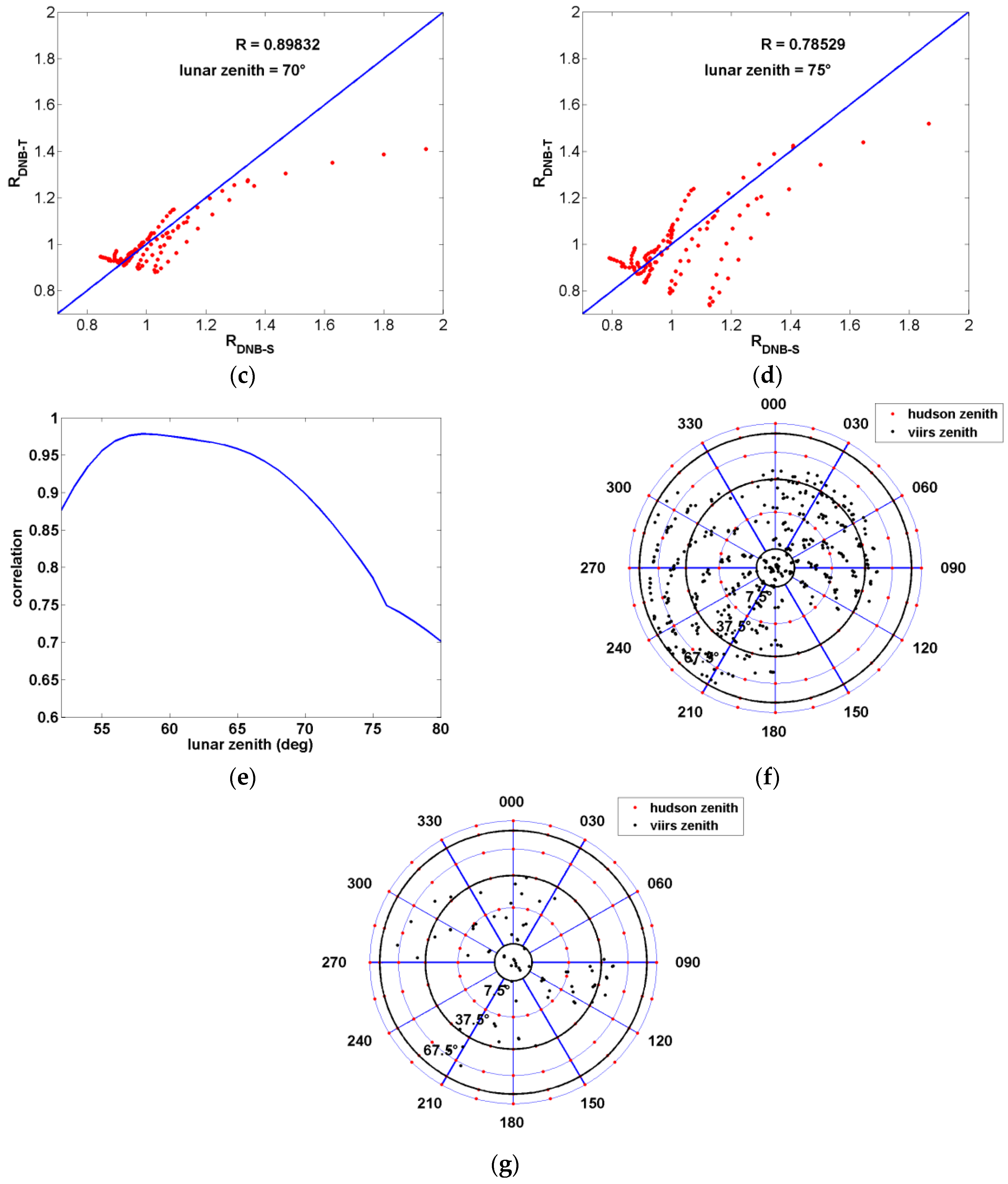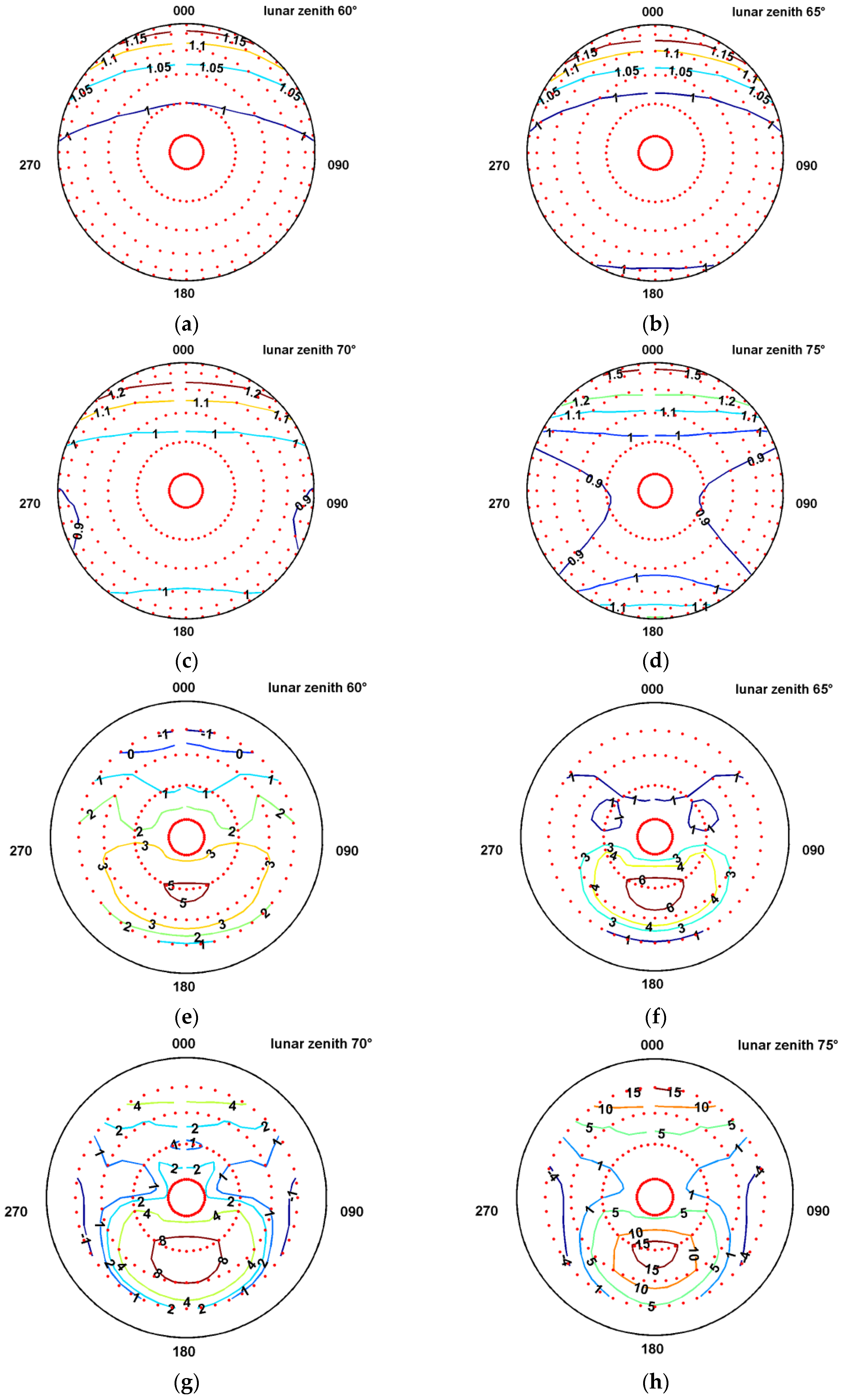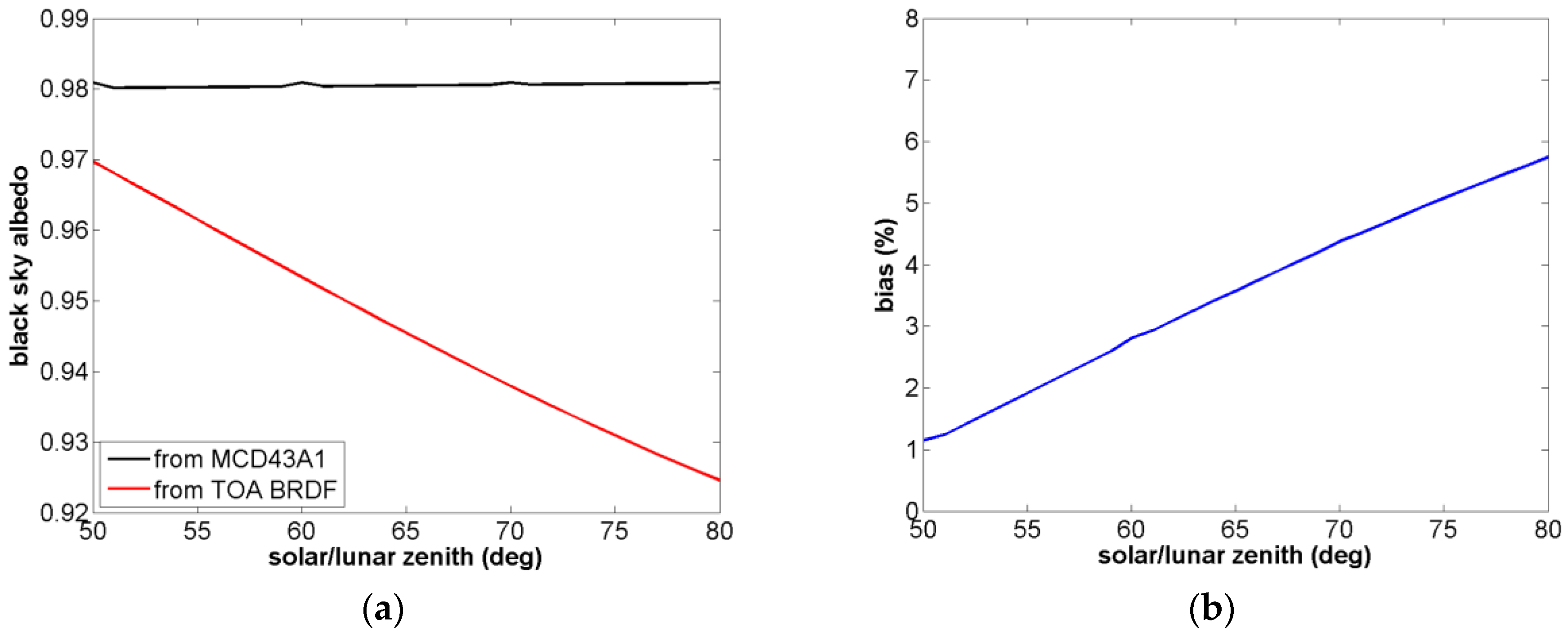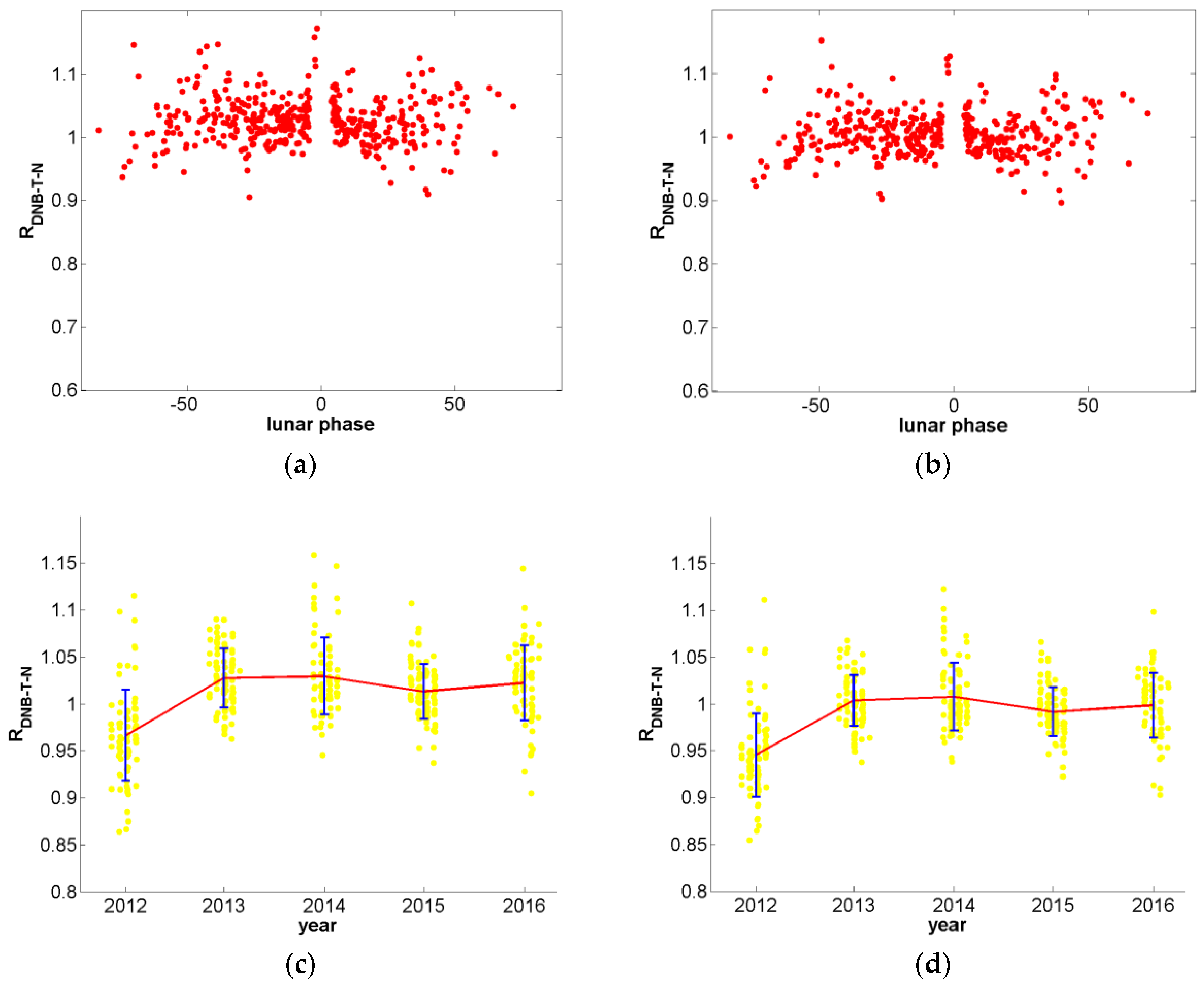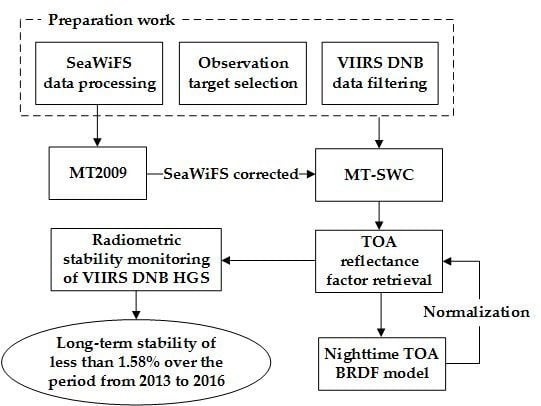In this study, the Dome C site is selected as the observation target to evaluate the radiometric stability of DNB HGS. The overall procedures of analysis are: selection of observations, retrieval of nighttime reflectance, correction of the MT2009 lunar irradiance model using SeaWiFS lunar observations, characterization of the BRDF effect of Dome C and its removal, and the analysis of radiometric stability of the DNB. The details of the analysis method are described below.
2.6. Correction of MT2009 Using Lunar Observations from SeaWiFS
In this study, the SeaWiFS lunar observations are used to correct the MT2009 lunar irradiance model, in particular, to account for dependence of lunar irradiance on the waxing and waning lunar phases. The SeaWiFS instrument onboard the SeaStar spacecraft was launched to low Earth orbit on 1 August 1997. It has eight RSBs, whose central wavelengths and bandwidths are shown in
Table 2. As part of the calibration strategy, the SeaWiFS Project uses monthly lunar calibrations to monitor the on-orbit radiometric stability of SeaWiFS over the course of its mission [
20,
35]. The measurements are made at near-full moon and are later extended to high lunar phase angles. The long-term stability value of the SeaWiFS TOA radiances is 0.13%, which is derived from the lunar time series. The precision of the SeaWiFS measurement is 0.16% using solar calibration and 0.13% using lunar calibration [
36]. A typical calibrated lunar image in Band 1 is shown in
Figure 4a. The lunar phase angle was 5.71 degrees on 10 July 1998. The image has 100 scan lines from top to bottom and each scan line contains 100 samples.
In this study, the samples in the central core of the lunar images with radiance greater than 1% of maximum radiance are qualified as lunar pixels. The lunar signal is determined to be the summation of qualified pixel radiance in each scan line and is shown in
Figure 4b. The disk-integrated radiance is calculated by summing up all the lunar signals in each scan line. By multiplying the solid angle of each lunar pixel with the disk-integrated radiance, the lunar irradiance is derived [
37]. The lunar irradiance is then corrected to the mean Earth/Sun and mean Earth/Moon distance for model construction.
Since the mismatch between sampling rate and rotation rate of the spacecraft during the measurement causes elongation in the vertical direction in the lunar image, the derived lunar irradiance is, thus, over-estimated [
37,
38]. The lunar irradiance is corrected by applying an oversampling factor, which is defined as the ratio of the elongated lunar size to the expected lunar size [
38]:
where
is the mean instrument—Moon distance, i.e., 384,400 km,
Dim is the instrument—Moon distance, and
Ynom = 5.625 is the expected Moon diameter in terms of number of SeaWiFS pixels at the mean instrument—Moon distance.
Yelon is the elongated Moon size in the image. It is defined as the separation between the top and bottom edge of the Moon [
19]. The uncertainty in determining
Yelon is the major error source in SeaWiFS lunar observations. The oversampling factor
fs is calculated at the mean instrument—Moon distance since the lunar irradiance has been corrected to the mean instrument—Moon distance.
The bias between the SeaWiFS lunar observations and MT2009 is defined by:
where
ISeaWiFS is the SeaWiFS lunar irradiance and
IMT2009 is the lunar irradiance simulated with the MT2009 model. The bias
δb(
B) derived for eight SeaWiFS bands is interpolated to be
δb(
λ) in 1-nm resolution for the DNB spectral region; the bias
δb-DNB for the DNB spectral region is derived using Equation (6):
Given the bias
δb-DNB derived from the SeaWiFS lunar observations for different lunar phase angles, least square fitting is applied to derive the bias function under different lunar phase
δb-DNB(Φ). The correction factor
fc(Φ) for the MT2009 lunar irradiance model is defined by:
where Φ represents lunar phase angle. The lunar irradiance derived from MT2009 is corrected using Equation (8):
The corrected version of MT2009 is called the MT2009 SeaWiFS Corrected (MT-SWC) lunar irradiance model.
2.7. The Anisotropic Reflectance Factor Model of the Dome C Site
The bidirectional reflectance factor function (BRDF) describes the scattering of a parallel beam of incident light from one direction in the hemisphere into another direction in the hemisphere [
39]. It is expressed as the ratio of infinitesimal quantities shown in Equation (9).
L(
θr,
ϕr) represents the radiance reflected into the direction of (
θr,
ϕr),
E(
θi,
ϕi) represents the incident flux from the direction of (
θi,
ϕi), and
ϕ equals
ϕv −
ϕ0.
The definition of lunar zenith angle (
θ0), viewing zenith angle (
θv), lunar azimuth angle (
ϕ0), viewing azimuth angle (
ϕv), and relative azimuth angle (
ϕ) are shown in
Figure 5, where the zenith angle is measured from the
z-axis and the azimuth angle is measured clockwise from the north (0°). The relative azimuth is defined as the angle measured clockwise from the lunar azimuth angle to the VIIRS azimuth angle [
28].
The BRDF is expressed as the ratio of infinitesimal quantities, it cannot be directly measured. We choose to use the measurements in the form of the anisotropic reflectance factor (
R), which is defined as follows:
where
indicates the radiance reflected to the direction of (
θv,
ϕv) by Dome C when the incident moonlight is from the direction of (
θ0,
ϕ0). The numerator of the equation indicates the reflected radiance integrated over the entire hemisphere.
The incident moonlight can be divided into two parts: the direct moonlight, and the diffuse moonlight. The bidirectional reflectance factor (BRF) is defined by the ratio of the reflected radiant flux from the surface area to the reflected radiant flux from an ideal and diffuse surface of the same area under identical view geometry and single direction illumination. The hemispherical directional reflectance factor (HDRF) has the same definition as the BRF except that the incident flux is from the entire hemisphere [
28,
39,
40]. The measured reflectance factor is interpolated between the
BRF and the
HDRF, which is given in Equation (11), where
d ranges between 0 and 1 and denotes the fractional amount of direct radiant flux [
40].
Since the atmospheric influence is low at the Dome C site, the influence of diffuse moonlight is small when lunar zenith angle is small. Therefore, the reflectance factor can be written in the form of Equation (12):
where
indicates the irradiance of direct moonlight from the direction of (
θ0,
ϕ0).
Since the atmospheric effect at the Dome C site is small, the amount of direct moonlight reaching to the ground is large. However, as the lunar zenith angle is increasing, the influence of atmosphere is also increasing.
The spectral albedo (
α) is actually the bihemispherical reflectance (BHR), which is the ratio of reflected to incident flux as a function of wavelength [
40]. If the atmospheric influence is not taken into account,
α can be written in the form of Equation (13):
where the numerator of the equation indicates the reflected radiance integrated over the entire hemisphere, and the denominator of the equation indicates the incident radiance integrated over the entire hemisphere.
Combining Equations (10), (12), and (13), the relationship between the anisotropic reflectance factor (
R) from the Hudson model and the reflectance factor (
r) derived from the DNB is given in Equation (14):
where
ϕ denotes relative azimuth angle defined in
Figure 5. The albedo
α is obtained from the measurements made by Hudson et al. [
28,
30,
41].
As we mentioned earlier in the paper, the BRDF effect is strong at Dome C. Thus, to accurately evaluate the radiometric stability of DNB HGS, the BRDF effect due to different view geometries with varying lunar zenith angles and sensor viewing angles needs to be taken into account and removed. Many studies have been performed to characterize the BRDF at Dome C. Warren et al. [
27] measured the anisotropic reflectance factor at the South Pole Station at 0.60, 0.66, and 0.90 μm with a solar zenith angle from 67 to 89 degrees. Hudson et al. [
28] extended the measurements of Warren et al. [
27] by covering a broader spectral range (from 0.35 to 2.4 μm) with higher spectral resolution (3 to 30 nm) and a wider range of solar zenith angles (from 51 to 87 degrees). Wu et al. [
29] compared the Warren model with the TOA reflectance factor over Dome C observed by MODIS during the daytime and found that the Warren model matches the TOA reflectance factor by better than 5%. According to the radiative transfer simulations by moderate resolution atmospheric transmission (MODTRAN), the dominant atmospheric effects at the Dome C site are Rayleigh scattering and ozone absorption, which can have strong effects only upon short wavelengths, especially below 500 nm [
30,
32,
42].
According to Warren et al., the
R can be represented in terms of
ϕ [
27]:
where the
c1,
c2,
c3 is represented by
θv:
The coefficients
ai, (
i = 0, 1, 2, and 3) are a quadratic function of cos
θ0:
where the 12 coefficients
b0i,
b1i,
b2i (
i = 0, 1, 2, and 3) can be estimated by a least-squares best fit to the measurements. Since the intention of this paper is to monitor the stability of the radiometric stability of VIIRS DNB HGS, the atmospheric effects at the Dome C site are not considered when parameterization is performed.
In this study, we choose to use the model developed by Hudson et al. to characterize the BRDF effect of Dome C during the daytime. The measurements made by Hudson et al. are modeled with the first two terms of the empirical orthogonal functions (EOFs) which determine the dominant fraction of the variance in the data. There are, in total, 1775 different angular patterns with observations made at 71 different solar zenith angles and 25 different wavelengths. Each angular pattern contains samples of
R gridded at six viewing zenith angles and 48 viewing azimuth angles. The measurements are divided into six different groups based on the different spectral region and solar zenith angle. Each group of measurements is used to perform the parameterization of the model in Equation (18):
For each angular pattern, R is a 288 × 1 vector, 1 is a 288 × 1 vector of ones, U is a 288 × 2 matrix whose first column corresponds to the first EOFs and the second column corresponds to the second EOFs, Σ is a 2 × 2 diagonal matrix with positive scale factors on the diagonal, and V is a 1 × 2 vector. We only use the first two groups of parameterization considering the spectral region of DNB and the range of the lunar zenith angle.
We choose the model developed by Hudson et al. for the following two reasons: (1) the range of the solar zenith angles in the measurements made by Hudson et al. covers the range of lunar zenith angles at the Dome C site observed by the VIIRS DNB; and (2) the spectral resolution of Hudson is higher than for the measurements taken by Warren et al. and it is more suitable for the DNB since the DNB is a panchromatic RSB. The modeled
RS(
B) in each sampled band is interpolated to derive the
RS(
λ) at 1-nm resolution over the DNB spectral region from 500 nm to 900 nm.
RS(
λ) is then convoluted with
RSR(
λ) to obtain the surface
R of DNB (
RDNB-S) at the Dome C site:
Figure 6 shows the results of the anisotropic reflectance factor
R in DNB spectral region under different lunar zenith angles using the model developed by Hudson et al. The red points indicate the samples
RDNB-S placed every 15 degrees in both the viewing zenith angle and relative azimuth angle starting at 22.5 degrees and 0 degrees, respectively.
Figure 6 shows that the patterns of
RDNB-S change from a nearly isotropic form to an anisotropic form as the lunar zenith angle increases, indicating a progression from a nearly Lambertian reflectance to a strongly forward-peaked reflectance. The nadir view
RDNB-S decreases as the lunar zenith angle increases.
The TOA BRDF model is developed by best least square fitting of the analytical function of Warren model to the TOA reflectance factor derived from the VIIRS DNB. TOA R values for the VIIRS DNB, denoted as RDNB-T, are determined by applying Equation (14). The anisotropic reflectance factor RDNB-S derived from the Hudson et al. model is used as a reference for comparison with the nighttime TOA BRDF model.

